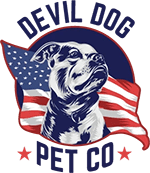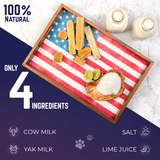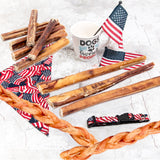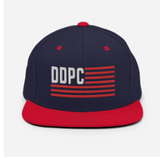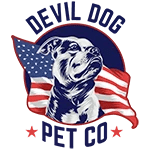Key Takeaways
- Rawhide chews pose significant health risks, including choking hazards and exposure to harmful chemicals used in leather processing.
- Dogs require daily chewing for mental health and dental hygiene, but no chew is completely risk-free, making supervision and proper sizing essential.
- Premium rawhide alternatives must be digestible, appropriately hard, dental-beneficial, ethically sourced, and free from chemical processing.
- Natural options like Himalayan yak chews, wild elk antlers, and premium bully sticks offer safer, more nutritious, and longer-lasting chewing experiences.
- Compared to rawhide, alternatives provide superior safety, digestibility, and dental benefits, making them the better choice for responsible dog owners.
Table of Contents
- Why You Need Rawhide Alternatives, The Unfiltered Truth
- The Science (and Grit) Behind Every Chew: What Makes a Good Rawhide Alternative
- Rawhide Alternatives You Can Trust: Full Rundown of Premium Products and Natural Options
- Head-to-Head Comparison: Rawhide vs. Top Alternatives (Tables + Hard Truths)
- Safety First: Avoiding Trouble with Alternative Chews
- How to Choose the Right Rawhide Alternative for Your Dog (Beginner to Advanced)
- Real-World Scenarios: Matching Devil Dog Chews to Dog Owner Challenges
- Home-Made Alternatives and How-To's: Recipes, Preparation, and Pros/Cons
- Devil Dog Leadership: Building Smart Chewing Habits (Owner Accountability)
- Where to Buy, How to Save, DDPC Shopping & Product Guidance
Devil Dog Pet Co: The Ultimate Guide to Alternatives to Rawhide for Dogs
Why You Need Rawhide Alternatives, The Unfiltered Truth
Rawhide isn't just outdated, it's dangerous. Veterinary emergency rooms report thousands of choking incidents annually from rawhide chunks that swell in dogs' throats. Mass-market rawhides contain bleach, formaldehyde, and other chemicals used in leather processing. When our dog Dexter chipped a molar on bargain rawhide years ago, we learned this lesson the hard way.
Alternatives to rawhide for dogs aren't just safer, they're essential for mental health, dental hygiene, and behavioral stability. But here's the reality check: no chew is risk-free. Proper sizing, supervision, and knowing your dog's chewing style remain non-negotiable, regardless of what you choose.
The documented risks speak volumes: rawhide pieces can expand 3-4 times their dry size when wet, creating intestinal blockages requiring emergency surgery. Chemical residues from processing can trigger allergic reactions and digestive upset. Smart owners make the switch, not just for safety, but for superior nutrition and longer-lasting value. For a high-protein, fully digestible option, consider these Ultra Thick Bully Sticks as a premium alternative.
Download the FREE 10-Step Dog Prep Guide
The Science (and Grit) Behind Every Chew: What Makes a Good Rawhide Alternative

Premium rawhide alternatives must meet five non-negotiable criteria: complete digestibility, appropriate hardness (6-7 on Mohs scale for most dogs), proven dental benefits, ethical sourcing, and zero chemical processing. These aren't marketing buzzwords, they're survival requirements based on canine anatomy and psychology.
Elk antlers rate 6.5 on the Mohs hardness scale, providing optimal plaque scraping without excessive tooth wear. Clinical studies show natural chews reduce tartar buildup by 47% more effectively than synthetic alternatives. Our dog Dexter chews for exactly 17 minutes before switching activities, most dogs need session limits to prevent jaw fatigue and overconsumption.
- Single-ingredient or minimal processing
- Digestible within 24-48 hours
- Size larger than dog's mouth width
- Source transparency and ethical harvesting
- No artificial preservatives, colors, or flavors
The difference between a good chew and a great one lies in sourcing integrity. Wild-shed elk antlers contain 12% protein and essential minerals without environmental impact. Grass-fed beef products eliminate hormone residues found in conventional alternatives. These details matter when you're feeding something your dog will gnaw for hours. For a deeper dive into the pros and cons of antlers, see are antlers for dogs a good idea.
Rawhide Alternatives You Can Trust: Full Rundown of Premium Products and Natural Options
Devil Dog Pet Co.'s Specialty Lineup:Himalayan Yak Chews - The Digestible Powerhouse
Best for: Heavy chewers needing long-lasting, fully digestible options
Crafted from yak and cow milk using traditional Nepalese methods, these rock-hard chews soften gradually with saliva, making every piece completely digestible. Unlike rawhide, swallowed fragments break down like regular food. A single Monster-size yak chew provides 2-3 weeks of entertainment for most dogs.
Wild Elk Antler Chews - Maximum Durability
Best for: Power chewers who destroy everything else
Naturally shed Rocky Mountain elk antlers contain zero additives, just pure bone matrix packed with calcium, phosphorus, and zinc. Whole antlers last 4-6 weeks for moderate chewers; split antlers expose tasty marrow for picky dogs. These are the marathon runners of the chew world. If you're looking for a substantial option, try the Extra Large Whole Elk Antler.
Premium Bully Sticks - The Protein Champion
Best for: Dogs needing softer, fully edible chews with maximum flavor
Single-ingredient beef pizzle, triple-washed and slow-baked for 20+ hours. Our Ultra-Thick versions resist even determined chewers while providing complete digestibility. At 3% fat and 85% protein, they're nutritionally superior to any rawhide alternative. For more on safety, read bully sticks for dogs: are they safe?.
Natural Alternatives Worth Considering:- Beef tendons: Collagen-rich, moderate hardness, fully digestible
- Fish skin rolls: Hypoallergenic, omega-3 rich, gentle on teeth
- Sweet potato chews: Homemade option, slice ¼-inch thick, bake at 250°F for 3 hours
| Chew Type | Digestibility | Average Duration | Dental Benefits | Calories (per oz) |
|---|---|---|---|---|
| Yak Chews | 100% | 2-3 weeks | High | 105 |
| Elk Antlers | Minimal | 4-6 weeks | Excellent | 15 |
| Bully Sticks | 100% | 20-60 minutes | Moderate | 88 |
| Rawhide | Poor | 30-90 minutes | Low | 95 |
Head-to-Head Comparison: Rawhide vs. Top Alternatives (Tables + Hard Truths)
When you strip away marketing fluff and face facts, alternatives to rawhide for dogs dominate across every metric that matters. Rawhide's chemical processing, poor digestibility, and choking risks make it the inferior choice for responsible owners who demand better.
Here's the unfiltered breakdown. Devil Dog Pet Co's premium chews consistently outperform rawhide in safety, nutrition, and value. Our elk antlers deliver 3-5 weeks of chew time versus rawhide's single session. Yak chews provide complete digestibility while rawhide creates blockage risks. Bully sticks offer single-ingredient purity against rawhide's chemical cocktail of bleach and formaldehyde.
| Chew Type | Processing | Digestibility | Choking Risk | Nutritional Value | Cost Per Hour |
|---|---|---|---|---|---|
| Devil Dog Elk Antlers | Naturally shed, hand-cut | Mineral dust only | Low (proper sizing) | Calcium, phosphorus, zinc | $0.15 |
| Devil Dog Yak Chews | Smoke-dried, sun-cured | 100% digestible | Very low | High protein, low fat | $0.45 |
| Devil Dog Bully Sticks | Slow-baked, single ingredient | 100% digestible | Low (supervised) | High protein, amino acids | $0.85 |
| Rawhide | Chemical bleaching, artificial hardening | Poor, blockage risk | High | Minimal, processed collagen | $0.25 |
Military families and rescue households choose ethical alternatives because every dollar supports responsible sourcing. Our Rocky Mountain elk sheds fund conservation. Himalayan yak cooperatives receive fair wages. Grass-fed cattle operations maintain humane standards. Rawhide? Mass-produced in facilities with zero transparency and maximum chemical shortcuts. For a scientific perspective on rawhide safety, see this external resource on safer alternatives.
Safety First: Avoiding Trouble with Alternative Chews

Even the safest rawhide alternatives demand leadership and supervision. Size up every chew, choose pieces longer than your dog's muzzle and too wide to fit between back molars. Time sessions to 15-20 minutes for new chewers, extending as you learn their style. Rotate chew types weekly to prevent jaw fatigue and maintain interest.
Watch for red flags: excessive drooling, pawing at the mouth, or attempts to swallow large pieces. Loose stools after rich chews like yak or bully sticks signal too much too fast, reduce session length and frequency. Dexter once tried burying a yak chew in the backyard; we learned to rinse outdoor chews and inspect for dirt or debris before the next session.
Emergency Action: Signs Your Dog Needs Immediate Vet Care
- Persistent gagging or retching
- Refusing food or water for 12+ hours
- Bloody vomit or severe diarrhea
- Lethargy combined with abdominal pain
Retire chews early rather than risk problems. Antlers get replaced when worn to swallowable size. Bully stick nubs go in the trash, not the dog. Yak chew ends become microwave puffs, soak 5 minutes, microwave 45-90 seconds, cool completely, then serve the crunchy result. Smart owners keep replacement chews ready and never let dogs "finish" questionable pieces.
How to Choose the Right Rawhide Alternative for Your Dog (Beginner to Advanced)
Match chew intensity to jaw strength and dental health first. Puppies with adult teeth (5+ months) start with split antlers or Standard bully sticks. Seniors with worn molars stick to yak chews and soft vegetables. Power chewers graduate to Monster elk antlers and Jumbo braided bully sticks. Gentle gnawers thrive on Standard sizes across all categories. For a comparison of deer versus elk antlers, check out deer antler vs elk antler for dogs.
Factor in calories and session frequency. A 50-lb active dog burns through 300 calories of yak chew weekly without weight gain. Sedentary seniors need portion control, half that amount or shorter sessions. Becky's multi-dog household rotates three chew types: Monday antlers, Wednesday yak chews, Friday bully sticks. Each dog gets sized-up pieces to prevent resource guarding and ensure safety. For a multi-dog solution, try the 12" Braided Bully Stick 3-pack for extended chewing sessions.
| Dog Profile | Recommended Starter | Advanced Option | Session Length | Weekly Frequency |
|---|---|---|---|---|
| Puppy (5-12 months) | Split antler, Standard bully | Large yak chew | 10-15 minutes | 3-4 times |
| Adult power chewer | Whole antler, XL yak | Beast antler, Monster yak | 20-30 minutes | 2-3 times |
| Senior dog | Yak chew, soft veggies | Soaked yak, split antler | 10-15 minutes | 2-3 times |
| Multi-dog home | Jumbo bully, Monster yak | Beast antler, Braided bully | 15-20 minutes | 3-5 times |
Real-World Scenarios: Matching Devil Dog Chews to Dog Owner Challenges
Nancy's new rescue came with separation anxiety and destructive chewing habits. Her couch cushions paid the price until she implemented a structured chew routine: Monster yak chews during crate time, split antlers for supervised evening sessions. The key? Preemptive leadership, offering high-value alternatives to rawhide for dogs before problem behaviors escalate. For more on managing anxiety, see how to handle separation anxiety in dogs.
Becky manages three dogs with different energy levels and jaw strengths. Her rotation system prevents resource guarding while maximizing chew value: Beast elk antlers for the German Shepherd mix, Standard yak chews for the senior Beagle, braided bully sticks for the anxious rescue. Each dog gets sized-up pieces and timed sessions, no competition, no conflicts.
Challenge-to-Solution Quick Reference
- Destructive Chewing: Monster elk antlers + structured crate training
- Multi-Dog Households: Size up all chews, separate feeding areas
- Puppy Teething: Oversized split antlers, 10-minute supervised sessions
- Senior Dental Issues: Yak chews soaked briefly in warm water
- Weight Management: Antler chews (minimal calories) + extended sessions
Eli and Eva prepared their dog for baby arrival using calming chew routines. Evening yak chew sessions created positive associations with quiet time, reducing reactivity to crying and sudden movements. Enrique's eco-conscious audit led to Devil Dog's transparent sourcing: naturally shed antlers support elk conservation, fair-trade yak cooperatives receive living wages, grass-fed cattle operations maintain humane standards. For more information on dog treats in general, visit this encyclopedia entry on dog treats.
Home-Made Alternatives and How-To's: Recipes, Preparation, and Pros/Cons

Sweet potato chews deliver natural fiber and vitamins when prepared correctly. Slice sweet potatoes ¼-inch thick, arrange on parchment-lined baking sheets, and bake at 250°F for 3 hours until leathery but not brittle. Dexter's favorite preparation: slightly thicker slices that maintain chew resistance while providing satisfying crunch.
Frozen carrot sticks work for gentle chewers and teething puppies. Choose large carrots, cut into 4-inch sections, and freeze overnight. Supervise closely, soft vegetables can break into swallowable chunks faster than expected. Replace when worn to thumb-size or smaller.
DIY limitations demand honest assessment. Homemade chews spoil within days, require constant refrigeration, and lack the mineral content of premium rawhide alternative products. Sweet potatoes add calories that must be calculated into daily intake. Carrots provide minimal dental benefit compared to elk antlers' plaque-scraping action. Most owners find homemade options useful as occasional supplements, not primary chew solutions.
Storage warning: Homemade chews develop mold within 72 hours at room temperature. Refrigerate unused portions and inspect for fuzzy growth before each session. When in doubt, discard and start fresh.
Devil Dog Leadership: Building Smart Chewing Habits (Owner Accountability)
Extreme Dog Leadership transforms chew time from passive treat-giving into active behavioral training. Log chew sessions in your family calendar, track duration, chew type, and your dog's response. Adjust when stress levels spike or energy drops. Amanda and I monitor Dexter's chewing patterns like drill instructors tracking recruit progress: consistent schedules, measurable results, zero excuses for lapses.
Use chews strategically for obedience and anxiety management. Reward successful "place" commands with high-value yak chews. Deploy elk antlers during thunderstorms to redirect nervous energy. Create positive associations with crate time using split antlers that only appear during confinement periods.
Quarterly chew audits keep your leadership sharp. Evaluate which alternatives to rawhide for dogs your dog prefers, calculate cost-per-hour of entertainment, and adjust inventory accordingly. Successful owners maintain three chew types in rotation, size up rather than down when uncertain, and never run out of backup options.
The Devil Dog Promise: accountability-driven guidance, ethically sourced chews, and ongoing support for shelter prevention. Every chew choice reflects your leadership commitment, choose products that honor your dog's health and your values.
Where to Buy, How to Save, DDPC Shopping & Product Guidance
Order directly at devildogpetco.com for the full selection and freshest inventory. Free shipping kicks in at $35, perfect for stocking multiple chew types. Subscribe & Save delivers additional discounts while ensuring you never run out of your dog's favorites. Amazon and TikTok Shop offer convenient alternatives with the same quality guarantee.
Size matching eliminates guesswork and returns. Send photos to help@devildogpetco.com for personalized recommendations. Multi-dog households benefit from Monster or Beast sizes across all product lines, better value and reduced resource competition. Kennel and rescue operations qualify for bulk pricing through john@devildogpetco.com. For the toughest chewers, the Beast Himalayan Dog Chew offers unmatched durability and satisfaction.
| Product Category | Best for Chewer Type | Average Cost Per Hour | Subscription Savings |
|---|---|---|---|
| Elk Antlers (Whole) | Power chewers | $0.15 | 10% off |
| Yak Chews | Moderate to strong chewers | $0.45 | 10% off |
| Bully Sticks | All chewers | $0.85 | 10% off |
Download the FREE 10-Step Dog Prep Guide
Frequently Asked Questions
What are the main health risks associated with giving dogs rawhide chews?
Rawhide chews pose choking hazards due to pieces swelling or breaking off, risking blockages in the throat or intestines. They often contain chemical residues from leather processing, like bleach and formaldehyde, which can cause digestive upset or allergic reactions.
How do natural rawhide alternatives like Himalayan yak chews and elk antlers benefit my dog's dental health?
Natural alternatives provide safe, durable chewing that helps scrape plaque and strengthen jaw muscles without harsh chemicals. Yak chews offer a firm, edible texture that promotes saliva flow, while elk antlers deliver slow grinding action that acts like a natural toothbrush.
What criteria should I consider when choosing a safe and effective rawhide alternative for my dog?
Look for chews that are digestible, free from chemical processing, appropriately hard for your dog's chewing style, and ethically sourced. Dental benefits, durability, and minimal mess or odor are also key factors to ensure safety and enjoyment.
Why is supervision and proper sizing important even when using safer chew alternatives?
No chew is completely risk-free; supervision helps prevent choking or swallowing large pieces. Proper sizing ensures the chew is too big to swallow whole but manageable to gnaw, reducing dental damage and digestive issues.
